梵蒂冈圣彼得大教堂英文版
梵蒂冈介绍英语
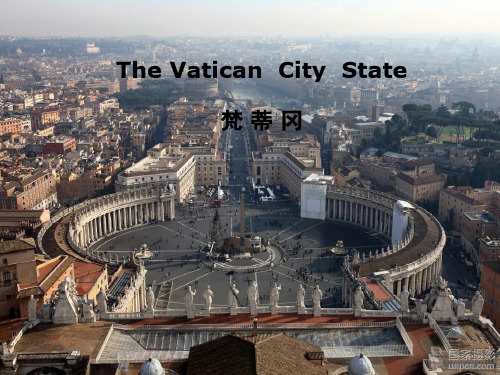
There are many large scale buildings in the Vatican, but not closely related to people's life a. The most typical is the Vatican is not a barber shop. If people want a haircut, you must go to Italy to.
Hale Waihona Puke Sistine Chapel(西斯廷教堂)
The Sistine chapel say again "Sistine chapel" near st. Peter's cathedral, to Michelangelo painted genesis dome painting, and the final judgment of murals and famous. Is the Pope's elected in the ceremony held. 西斯廷教堂又称“西斯廷礼拜堂”近邻圣彼得大教堂,以米开朗基罗所绘《创世 纪》穹顶画,及壁画《最后的审判》而闻名。也是教皇的选出仪式的举行处。
《创世纪》
——米开朗基罗
The Vatican museum is located in Rome, Italy north st. Peter's church, the original is the Pope palace. Rare collection of cultural relics and art treasures, Campbell and British museum, London and Paris comparable to the Louvre. A total area of 55000 square meters. 梵蒂冈博物馆位于意大利罗马圣彼得教堂北面,原是教皇宫廷。所收集的稀世文 物和艺术珍品,堪与伦敦大英博物馆和巴黎卢浮宫向媲美。总面积5.5万平方米。
介绍梵蒂冈的英语作文
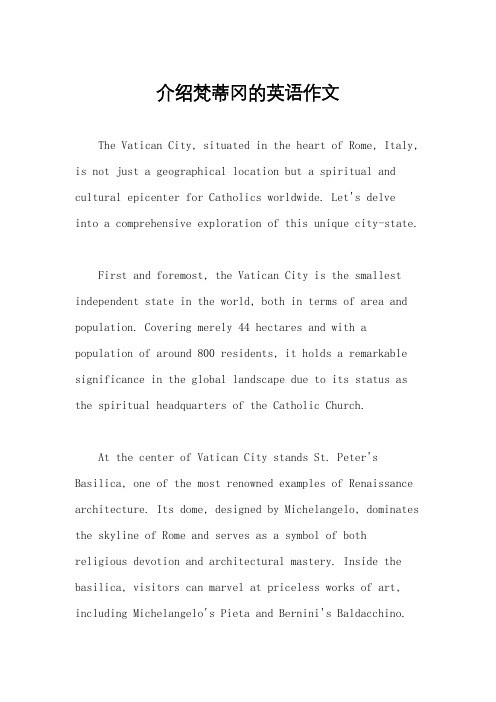
介绍梵蒂冈的英语作文The Vatican City, situated in the heart of Rome, Italy, is not just a geographical location but a spiritual and cultural epicenter for Catholics worldwide. Let's delveinto a comprehensive exploration of this unique city-state.First and foremost, the Vatican City is the smallest independent state in the world, both in terms of area and population. Covering merely 44 hectares and with a population of around 800 residents, it holds a remarkable significance in the global landscape due to its status as the spiritual headquarters of the Catholic Church.At the center of Vatican City stands St. Peter's Basilica, one of the most renowned examples of Renaissance architecture. Its dome, designed by Michelangelo, dominates the skyline of Rome and serves as a symbol of bothreligious devotion and architectural mastery. Inside the basilica, visitors can marvel at priceless works of art, including Michelangelo's Pieta and Bernini's Baldacchino.Adjacent to St. Peter's Basilica is St. Peter's Square, an iconic gathering place for pilgrims and tourists alike. Designed by Gian Lorenzo Bernini, the square features a grand colonnade that embraces visitors as they enter, creating a sense of awe and reverence. At the center of the square stands an ancient Egyptian obelisk, a testament to the Vatican's rich history and cultural influence.Another must-visit attraction within Vatican City is the Vatican Museums, which house one of the most extensive art collections in the world. From ancient Egyptianartifacts to Renaissance masterpieces, the museums offer a journey through the history of human creativity. Of course, the highlight of the Vatican Museums is the Sistine Chapel, renowned for its ceiling painted by Michelangelo. The frescoes, including the iconic depiction of the Creation of Adam, leave visitors spellbound with their beauty and complexity.Beyond its artistic and architectural treasures, the Vatican City also plays a vital role in global diplomacy.As the seat of the Holy See, it maintains diplomatic relations with countries around the world and serves as a mediator in international disputes. The Vatican's influence extends far beyond its borders, as evidenced by the numerous papal visits and diplomatic initiatives undertaken by successive pontiffs.Moreover, the Vatican City serves as a symbol of unity for Catholics worldwide. Every year, millions of pilgrims flock to Rome to attend papal audiences, participate in religious ceremonies, and deepen their faith. For many believers, a visit to the Vatican is a once-in-a-lifetime opportunity to connect with their religious heritage and experience the spiritual presence of the Holy See.In conclusion, the Vatican City stands as a testamentto the enduring power of faith, art, and diplomacy. Despite its small size, it looms large in the collectiveimagination of Catholics and non-Catholics alike, servingas a beacon of hope and inspiration for generations to come. Whether you're a devout believer, an art aficionado, or acurious traveler, a visit to the Vatican City is sure to leave a lasting impression on your mind and soul.。
意大利圣彼得大教堂简介
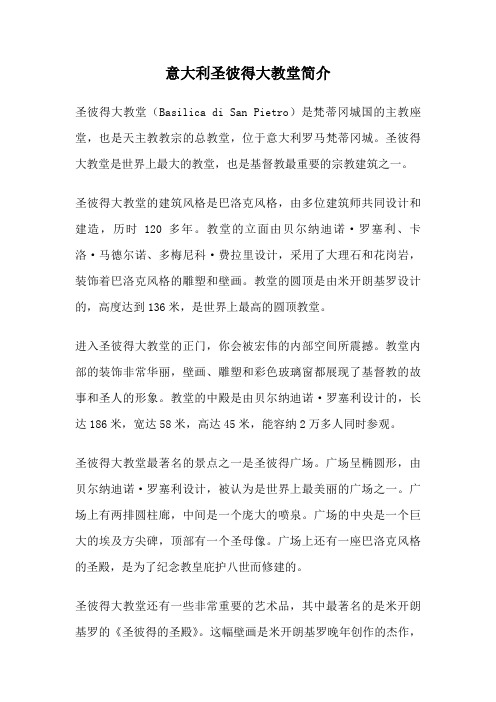
意大利圣彼得大教堂简介圣彼得大教堂(Basilica di San Pietro)是梵蒂冈城国的主教座堂,也是天主教教宗的总教堂,位于意大利罗马梵蒂冈城。
圣彼得大教堂是世界上最大的教堂,也是基督教最重要的宗教建筑之一。
圣彼得大教堂的建筑风格是巴洛克风格,由多位建筑师共同设计和建造,历时120多年。
教堂的立面由贝尔纳迪诺·罗塞利、卡洛·马德尔诺、多梅尼科·费拉里设计,采用了大理石和花岗岩,装饰着巴洛克风格的雕塑和壁画。
教堂的圆顶是由米开朗基罗设计的,高度达到136米,是世界上最高的圆顶教堂。
进入圣彼得大教堂的正门,你会被宏伟的内部空间所震撼。
教堂内部的装饰非常华丽,壁画、雕塑和彩色玻璃窗都展现了基督教的故事和圣人的形象。
教堂的中殿是由贝尔纳迪诺·罗塞利设计的,长达186米,宽达58米,高达45米,能容纳2万多人同时参观。
圣彼得大教堂最著名的景点之一是圣彼得广场。
广场呈椭圆形,由贝尔纳迪诺·罗塞利设计,被认为是世界上最美丽的广场之一。
广场上有两排圆柱廊,中间是一个庞大的喷泉。
广场的中央是一个巨大的埃及方尖碑,顶部有一个圣母像。
广场上还有一座巴洛克风格的圣殿,是为了纪念教皇庇护八世而修建的。
圣彼得大教堂还有一些非常重要的艺术品,其中最著名的是米开朗基罗的《圣彼得的圣殿》。
这幅壁画是米开朗基罗晚年创作的杰作,描绘了圣彼得的形象和他在教堂建设中的重要角色。
此外,教堂还收藏着许多其他艺术家的作品,如拉斐尔、伦勃朗和卡拉瓦乔等。
每年有数百万游客来到圣彼得大教堂参观,这里也是天主教教宗举行重要宗教仪式的地方。
如果你想参观圣彼得大教堂,建议提前预订门票,以免排队等候。
总的来说,圣彼得大教堂是一座宏伟壮丽的教堂,不仅是天主教徒的重要宗教场所,也是艺术和建筑的杰作。
无论你是基督教徒还是艺术爱好者,都值得一次亲自去体验这座神圣而美丽的建筑。
梵蒂冈圣彼得大教堂英文版
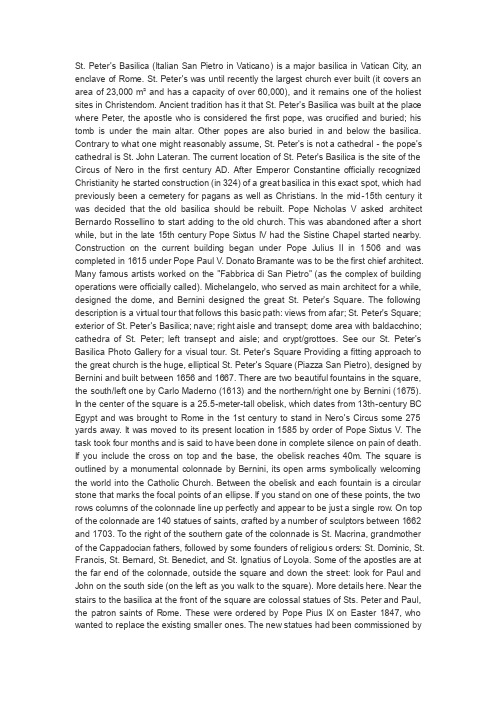
St. Peter's Basilica (Italian San Pietro in Vaticano) is a major basilica in Vatican City, an enclave of Rome. St. Peter's was until recently the largest church ever built (it covers an area of 23,000 m² and has a capacity of over 60,000), and it remains one of the holiest sites in Christendom. Ancient tradition has it that St. Peter's Basilica was built at the place where Peter, the apostle who is considered the first pope, was crucified and buried; his tomb is under the main altar. Other popes are also buried in and below the basilica. Contrary to what one might reasonably assume, St. Peter's is not a cathedral - the pope's cathedral is St. John Lateran. The current location of St. Peter's Basilica is the site of the Circus of Nero in the first century AD. After Emperor Constantine officially recognized Christianity he started construction (in 324) of a great basilica in this exact spot, which had previously been a cemetery for pagans as well as Christians. In the mid-15th century it was decided that the old basilica should be rebuilt. Pope Nicholas V asked architect Bernardo Rossellino to start adding to the old church. This was abandoned after a short while, but in the late 15th century Pope Sixtus IV had the Sistine Chapel started nearby. Construction on the current building began under Pope Julius II in 1506 and was completed in 1615 under Pope Paul V. Donato Bramante was to be the first chief architect. Many famous artists worked on the "Fabbrica di San Pietro" (as the complex of building operations were officially called). Michelangelo, who served as main architect for a while, designed the dome, and Bernini designed the great St. Peter's Square. The following description is a virtual tour that follows this basic path: views from afar; St. Peter's Square; exterior of St. Peter's Basilica; nave; right aisle and transept; dome area with baldacchino; cathedra of St. Peter; left transept and aisle; and crypt/grottoes. See our St. Peter's Basilica Photo Gallery for a visual tour. St. Peter's Square Providing a fitting approach to the great church is the huge, elliptical St. Peter's Square (Piazza San Pietro), designed by Bernini and built between 1656 and 1667. There are two beautiful fountains in the square, the south/left one by Carlo Maderno (1613) and the northern/right one by Bernini (1675). In the center of the square is a 25.5-meter-tall obelisk, which dates from 13th-century BC Egypt and was brought to Rome in the 1st century to stand in Nero's Circus some 275 yards away. It was moved to its present location in 1585 by order of Pope Sixtus V. The task took four months and is said to have been done in complete silence on pain of death. If you include the cross on top and the base, the obelisk reaches 40m. The square is outlined by a monumental colonnade by Bernini, its open arms symbolically welcoming the world into the Catholic Church. Between the obelisk and each fountain is a circular stone that marks the focal points of an ellipse. If you stand on one of these points, the two rows columns of the colonnade line up perfectly and appear to be just a single row. On top of the colonnade are 140 statues of saints, crafted by a number of sculptors between 1662 and 1703. To the right of the southern gate of the colonnade is St. Macrina, grandmother of the Cappadocian fathers, followed by some founders of religious orders: St. Dominic, St. Francis, St. Bernard, St. Benedict, and St. Ignatius of Loyola. Some of the apostles are at the far end of the colonnade, outside the square and down the street: look for Paul and John on the south side (on the left as you walk to the square). More details here. Near the stairs to the basilica at the front of the square are colossal statues of Sts. Peter and Paul, the patron saints of Rome. These were ordered by Pope Pius IX on Easter 1847, who wanted to replace the existing smaller ones. The new statues had been commissioned bythe previous pope for St. Paul Outside the Walls. Peter was sculpted by Giuseppe De Fabris in 1838-40 and stands 5.55m in height, on a pedestal 4.91m high. Paul was sculpted in 1838 by AdamoTadolini, and is also 5.55m in height, on a pedestal 4.91m high. Exterior of St. Peter's Basilica The dome of St. Peter's was designed by Michelangelo, who became chief architect in 1546. At the time of his death (1564), the dome was finished as far as the drum, the base on which domes sit. The dome was vaulted between 1585 and 1590 by the architect Giacomo della Porta with the assistance of Domenico Fontana, who was probably the best engineer of the day. Fontana built the lantern the following year, and the ball was placed in 1593. The great double dome is made of brick and is 42.3 metres in interior diameter (almost as large as the Pantheon), rising to 120 metres above the floor. In the early 18th century cracks appeared in the dome, so four iron chains were installed between the two shells to bind it. The four piers of the crossing that support the dome are each 60 feet (18 meters) across. Uniquely, Michelangelo's dome is not a hemisphere, but a parabola: it has a vertical thrust, which is made more emphatic by the bold ribbing that springs from the paired Corinthian columns, which appear to be part of the drum, but which stand away from it like buttresses, to absorb the outward thrust of the dome's weight. Above, the vaulted dome rises to Fontana's two-stage lantern, capped with a spire. The grand façade is 116 m wide and 53 m high. Built from 1608 to 1614, it was designed by Carlo Modeno. The central balcony is called the Loggia of the Blessings, and is used for the announcement of the new pope with "HabemusPapum" and his UrbietOrbi blessing. The relief under the balcony, by Buonvicino, represents Christ giving the keys to St. Peter. The facade is topped by 13 statues in travertine. From left, the statues represent: Thaddeus, Matthew, Philip, Thomas, James the Elder, John the Baptist, Christ the Redeemer (in the center), Andrew, John the Evangelist, James the Younger, Bartholomew, Simon and Matthias. St. Peter's statue in this set is inside. Two clocks are on either side; the one on the left is electrically operated since 1931, with its oldest bell dating to 1288. Stretching across the facade is the dedicatory inscription: IN HONOREM PRINCIPIS APOST PAVLVS V BVRGHESIVS ROMANVS PONT MAX AN MDCXII PONT VII (In honor of the prince of apostles; Paul V Borghese, pope, in the year 1612 and the seventh year of his pontificate) Between the façade and the interior is the portico. Mainly designed by Maderno, it contains an 18th century statue of Charlemagne by Cornacchini to the south, and an equestrian sculpture of Emperor Constantine by Bernini (1670) to the north.。
梵蒂冈圣彼得大教堂
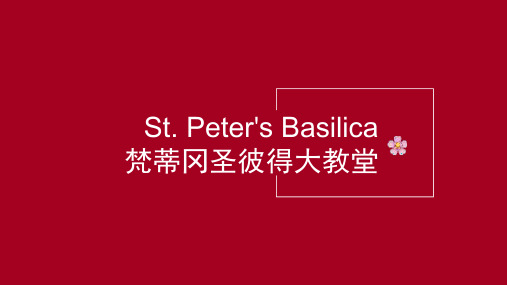
造了雄伟的穹顶。这个圆顶是华盛顿
特区美国国会大厦圆顶的灵感来源。
2.Arched dome 拱形圆屋顶
3. Column
4. Latin Cross
The center of church
The alter of the Pope 圣坛
St.Peter’s tumb 坟墓
St. Peter’s Tomb坟墓
Spectacle in St. Peter’s Basilica
Bishops and cardinals prepare themselves as Pope Benedict XVI leads Mass from underneath the high altar’s 95-foot-tall (29-metertall) bronze canopy in St. Peter's Basilica. 在圣彼得大教堂内高达95英尺(25米) 的青铜穹顶下,教宗本笃十六世带领 众主教和红衣主教做着弥撒前的准备。
1.the imposing dome
Michelangelo constructed the imposing
dome that sits atop St. Peter's Basilica.
This dome served as the inspiration for the dome on the United States Capitol Building in Washington, D.C. 米开朗基罗在圣彼得大教堂的顶上建
Basic Information
圣彼得大教堂是一座完全体现世俗风格的宗教建筑.位于意大利 首都罗马的西北角,一个面积只有
700的国家叫梵蒂冈,但它是基督教的中心教堂, 是全世界第一只有
梵蒂冈教堂英文作文
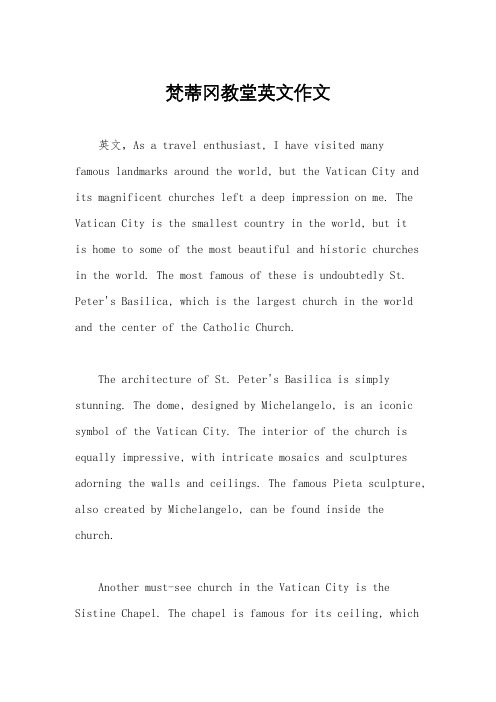
梵蒂冈教堂英文作文英文,As a travel enthusiast, I have visited many famous landmarks around the world, but the Vatican City and its magnificent churches left a deep impression on me. The Vatican City is the smallest country in the world, but itis home to some of the most beautiful and historic churches in the world. The most famous of these is undoubtedly St. Peter's Basilica, which is the largest church in the world and the center of the Catholic Church.The architecture of St. Peter's Basilica is simply stunning. The dome, designed by Michelangelo, is an iconic symbol of the Vatican City. The interior of the church is equally impressive, with intricate mosaics and sculptures adorning the walls and ceilings. The famous Pieta sculpture, also created by Michelangelo, can be found inside the church.Another must-see church in the Vatican City is the Sistine Chapel. The chapel is famous for its ceiling, whichwas painted by Michelangelo. The ceiling depicts scenes from the Bible, including the creation of Adam and the Last Judgment. The beauty and detail of the paintings are truly awe-inspiring.Aside from the churches, the Vatican City also has a rich history and culture. The Vatican Museums are home to some of the most significant works of art in the world, including the famous statue of Laocoön and His Sons. The Vatican also has its own post office and radio station, and the Swiss Guard, dressed in their colorful uniforms, can be seen patrolling the city.Overall, the Vatican City is a must-visit destination for anyone interested in history, art, or religion. The churches and museums are truly breathtaking, and the city's unique status as a separate country within Rome adds to its charm and allure.中文,作为一位旅行爱好者,我曾经去过世界上许多著名的地标,但梵蒂冈城和它的宏伟教堂给我留下了深刻的印象。
英语介绍几个国家标志性建筑

21、Cologne Cathedral( 阿根廷科隆大剧院)
布宜诺斯艾利斯的七月九日大街广场上的著名剧院。 是典型的文艺复兴式的庞然大物,仅次于纽约大都会歌剧院和米兰拉斯卡拉剧院的世界第三大歌剧院。
堡下面修建有20多公里长的地道、暗堡,是从坚硬的岩中开凿,工程颇为艰巨,其中地下防御通道是建立在几个不同的地理层面上,并同时向下延伸40米,工程可谓复杂。 这些给人深刻印象的防御体系在卢森堡被称为“北部的直布罗陀”。 1994年被联合国教科文组织列为世界遗产。
12,700 meters
The Great Wall
Sydney Opera House(悉尼歌剧院)
悉尼歌剧院位於澳洲悉尼,是20世纪最具特色的建筑之一,也是世界著名的表演艺术中心,悉尼市的标志性建筑。 该歌剧院1973年正式落成,2007年6月28日被联合国教科文组织评为世界文化遗产,该剧院设计者为丹麦设计师约恩.乌松。
1、The Great Wall
The Wall climbs up and down, twists and turns along the ridges of the Yanshan and Yinshan Mountain Chains through five provinces--Liaoning, Hebei, Shanxi, Shaanxi, and Gansu--and two autonomous regions--Ningxia and Inner Mongolia, binding the northern China together…
02
47 meters high in pedestal (基座高 ) 93 meters in total height bronze statue completed in 1886 located in New York French gift
圣彼得大教堂
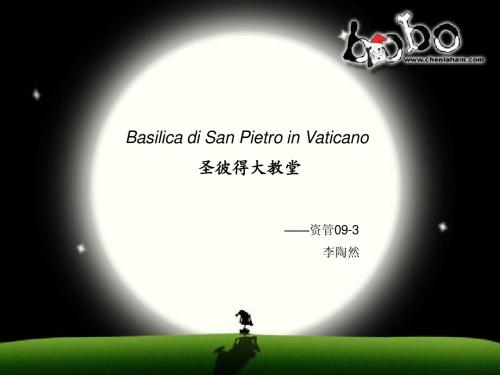
第一部分: 第一部分:宏伟的广场
教堂前的广场被两个半圆形 的长廊环绕,顶上有142 142个教会 的长廊环绕,顶上有142个教会 史上有名的圣男圣女的雕像, 史上有名的圣男圣女的雕像,雕 像人物神采各异、栩栩如生。 像人物神采各异、栩栩如生。广 场中间耸立着一座41 41米高的埃及 场中间耸立着一座41米高的埃及 方尖碑, 1856年竖起的 年竖起的, 方尖碑,是1856年竖起的,由一 整块石头雕刻而成。 整块石头雕刻而成。所有走进圣 彼得广场的人无不为这宏大的场 面而感慨。 面而感慨。
第二部分: 第二部分:圣彼得教堂
1、走廊 走廊 走进大教堂先经过一个走廊, 走进大教堂先经过一个走廊,走廊里带浅色花纹的白色大理石柱子上雕有精美 的花纹,从左到右长长的走廊的拱顶上有很多人物雕像, 的花纹,从左到右长长的走廊的拱顶上有很多人物雕像,整个黄褐色的顶面布满 立体花纹和图案。再通过一道门,才进入教堂的大殿堂, 立体花纹和图案。再通过一道门,才进入教堂的大殿堂,殿堂之宏伟令所有的参 观者惊叹,殿堂长 观者惊叹, 186米 总面积15000 186米,总面积15000 平方米,能容纳6 平方米,能容纳6万 人。高大的石柱和墙 拱形的殿顶、 壁、拱形的殿顶、到 处是色彩艳丽的图案、 处是色彩艳丽的图案、 栩栩如生的塑像、 栩栩如生的塑像、精 美细致的浮雕, 美细致的浮雕,彩色 大理石铺成的地面光 亮照人。 亮照人。
二、具体结构
整个教堂是由两部分组成: 整个教堂是由两部分组成: 1、圣彼得广场:教堂前面是能 圣彼得广场: 容纳30万人, 340米 30万人 240米 容纳30万人,长340米、宽240米, 被两个半圆形的长廊环绕, 被两个半圆形的长廊环绕,每个长 廊由284 284根高大的圆石柱支撑着长廊 廊由284根高大的圆石柱支撑着长廊 的顶,广场中间耸立着一座41 41米高 的顶,广场中间耸立着一座41米高 的埃及方尖碑, 1856年竖起的 年竖起的, 的埃及方尖碑,是1856年竖起的, 它是由一整块石头雕刻而成的。 它是由一整块石头雕刻而成的。 2、圣彼得教堂:整栋建筑平面 圣彼得教堂: 走势是一个十字架结构, 走势是一个十字架结构,造型充满 神圣的意味。教堂内部装饰华丽,人惶恐不安,令人窒息。
旅游英语:梵地冈圣彼得教堂
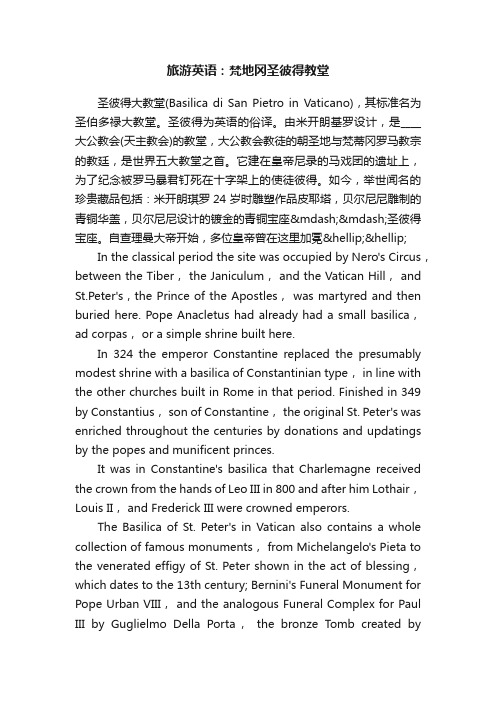
旅游英语:梵地冈圣彼得教堂圣彼得大教堂(Basilica di San Pietro in Vaticano),其标准名为圣伯多禄大教堂。
圣彼得为英语的俗译。
由米开朗基罗设计,是____大公教会(天主教会)的教堂,大公教会教徒的朝圣地与梵蒂冈罗马教宗的教廷,是世界五大教堂之首。
它建在皇帝尼录的马戏团的遗址上,为了纪念被罗马暴君钉死在十字架上的使徒彼得。
如今,举世闻名的珍贵藏品包括:米开朗琪罗24 岁时雕塑作品皮耶塔,贝尔尼尼雕制的青铜华盖,贝尔尼尼设计的镀金的青铜宝座——圣彼得宝座。
自查理曼大帝开始,多位皇帝曾在这里加冕……In the classical period the site was occupied by Nero's Circus,between the Tiber, the Janiculum, and the Vatican Hill, and St.Peter's,the Prince of the Apostles, was martyred and then buried here. Pope Anacletus had already had a small basilica,ad corpas, or a simple shrine built here.In 324 the emperor Constantine replaced the presumably modest shrine with a basilica of Constantinian type, in line with the other churches built in Rome in that period. Finished in 349 by Constantius, son of Constantine, the original St. Peter's was enriched throughout the centuries by donations and updatings by the popes and munificent princes.It was in Constantine's basilica that Charlemagne received the crown from the hands of Leo III in 800 and after him Lothair,Louis II, and Frederick III were crowned emperors.The Basilica of St. Peter's in Vatican also contains a whole collection of famous monuments, from Michelangelo's Pieta to the venerated effigy of St. Peter shown in the act of blessing,which dates to the 13th century; Bernini's Funeral Monument for Pope Urban VIII, and the analogous Funeral Complex for Paul III by Guglielmo Della Porta,the bronze Tomb created byAntonio Pollaiolo for Pope Innocent VIII, which was part of the original St. Peter's, and the neoclassic Monument to the Stuarts by Canova.重点词汇Michelangelo n. 米开朗基罗(意大利文艺复兴时期艺术家)Bernini n. 贝尔尼尼(意大利文艺复兴时期艺术家)circus n. 马戏团,杂技场Tiber n. 台伯河(意大利中部,流经罗马)apostle n. 耶稣十二使徒martyr v. 杀害pope n. 罗马教皇basilica n. (古罗马)长方形____shrine n. (小型)神殿,神祠Constantine (国王名)康斯坦丁donation n. 捐赠品,捐款munificent a. 慷慨的crown v. 加冕venerate v. 崇敬analogous a. 类似的,相似的neoclassic a. 新古典主义的文章二The fact, alone, that the great and truly unique Basilica of St. Peter's in Vatican faces out on this square wonld make it perhaps the most widely known of Roman piaz-zas. But above and beyond this, the space itself merits at-tention for its size (an enormous ellipse whose greatest di-ameter measures 240 m.) and the brilliant project by Gian Lorenzo Bernini whose scope was that of singling out this square from all others throngh the use of the imposing porticoes.These porticoes are arranged in semicircles along the short sides of the square and consist of four parallel rows of Tuscan-Doric columns which provide a choice of three paths. Above the canonic entablature are 140 colossal statues of Saints, as well as the insignia of the patron pope, Alexander VII. At the center of the square, the plain obelisk, flanked by two fountains, stands at the crossing of the two diameters of the ellipse. Termed " aguglia " (needle) in the Middle Ages, the obelisk came from Heliopolis and was brought to Rome by the em-peror Caligula, and set on the spina of Nero's Circus,which is where St. Peter's in Vatican now stands. Throughout the various phases of restoration, destruc-tion, and reconstruction, the " aguglia " stayed next to the Basilica and was not set up at the center of the square until 1586 by Domenico Fontana, who also saw to the en-ginecring aspect of the undertaking.The other architect, Carlo Fontana, designed the left-handiountain in Piazza San Pietro, built in 1677 as a pendant to the one on the right designed by Carlo Maderno about fifty years earli-er. A curious fact concerning the obelisk mentioned above is that it was used, or was believed to have been used in the Middle Ages, as a reliquary for the ashes of Caesar, and then (up to now) for a fragment of the Holy Cross.文章三San Pietro in Vincoli (Saint Peter in Chains) is a Roman Catholic titular church and minor basilica in Rome, Italy, best known for being the home of Michelangelo's statue of Moses, part of the tomb of Pope Julius II.Also known as the Basilica Eudoxiana, it was first rebuilt on older foundations[1] in 432–440 to house the relic of the chains that bound Saint Peter when he was imprisoned inJerusalem, the episode called the Liberation of Saint Peter. The Empress Eudoxia(wife of Emperor Valentinian III), who received them as a gift from her mother, Aelia Eudocia, consort of Valentinian II, presented the chains to Pope Leo I. Aelia Eudocia had received these chains as a gift from Iuvenalis, bishop of Jerusalem.According to legend, when Leo, while he compared them to the chains of St. Peter's final imprisonment in the Mamertine Prisonin Rome, the two chains miraculously fused together.[2] The chains are kept in a reliquary under the main altar in the basilica.The basilica, consecrated in 439 by Sixtus III, has undergone several restorations, among them a restoration by Pope Adrian I, and further work in the eleventh century. From 1471 to 1503, in which year he was elected Pope Julius II, Cardinal Della Rovere, the nephew of Pope Sixtus IV, effected notable rebuilding. The front portico, attributed to Baccio Pontelli, was added in 1475. The cloister (1493–1503) has been attributed to Giuliano da Sangallo. Further work was done at the beginning of the 18th century, under Francesco Fontana, and there was also a renovation in 1875.The Titulus S. Petri ad vincula was assigned on 20 November 2010, to Donald Wuerl. The previous Cardinal Priest of the basilica was Pío Laghi, who died on 11 January 2009.Two popes were elected in this church : Pope John II in 533 and Pope Gregory VII in 1073.Next to the church is hosted the Faculty of Engineering of La Sapienza University. This is named "San Pietro in Vincoli" per antonomasia. The church is located on the Oppian Hill near Cavour metro station, a short distance from the Colosseum.The interior has a nave and two aisles, with three apses divided by antiqueDoric columns. The aisles are surmounted by cross-vaults, while the nave has an 18th century coffered ceiling, frescoed in the center by Giovanni Battista Parodi, portraying the Miracle of the Chains (1706).Michelangelo's Moses (completed in 1515), while originally intended as part of a massive 47-statue, free-standing funeral monument for Pope Julius II, became the centerpiece of the Pope's funeral monument and tomb in this, the church of della Rovere family. Moses is depicted with horns, connoting "the radiance of the Lord", due to the similarity in the Hebrew words for "beams of light" and "horns". This kind of iconographic symbolism was common in early sacred art, and for an artist horns are easier to sculpt than rays of light.Other works of art include two canvases of Saint Augustine and St. Margaret by Guercino, the monument ofCardinal Girolamo Agucchi designed by Domenichino, who is also the painter of a sacristy fresco depicting theLiberation of St. Peter (1604). The altarpiece on the first chapel to the left is a Deposition by Cristoforo Roncalli. The tomb of Cardinal Nicholas of Kues (d 1464), with its relief, Cardinal Nicholas before St Peter, is by Andrea Bregno. Painter and sculptor Antonio Pollaiuolo is buried at the left side of the entrance. He is the Florentine sculptor who added the figures of Romulus and Remus to the sculpture of the Capitoline Wolf on the Capitol.[3] The tomb of Cardinal Cinzio Passeri Aldobrandini, decorated with imagery of the Grim Reaper, is also in the church.In 1876 archeologists discovered the tombs of those once believed to be the seven Maccabean martyrs depicted in 2 Maccabees 7–41.[4] It is highly unlikely that these are infact the Jewish martyrs that had offered their lives in Jerusalem. They are remembered each year on 1 August, the same day as the miracle of the fusing of the two chains.18th century fresco, The Miracle of the Chains in the center of the coffered ceiling by Giovanni Battista Parodi (1706).The third altar in the left aisle holds a mosaic of Saint Sebastian from the seventh century. This mosaic is related to an outbreak of plague inPavia, in northern Italy. It would only stop if an altar was built for St. Sebastian in the church of S. Pietro in Vincoli in that city. Somehow this story also became accepted in Rome. Hence the altar.。
圣彼得大教堂英文介绍
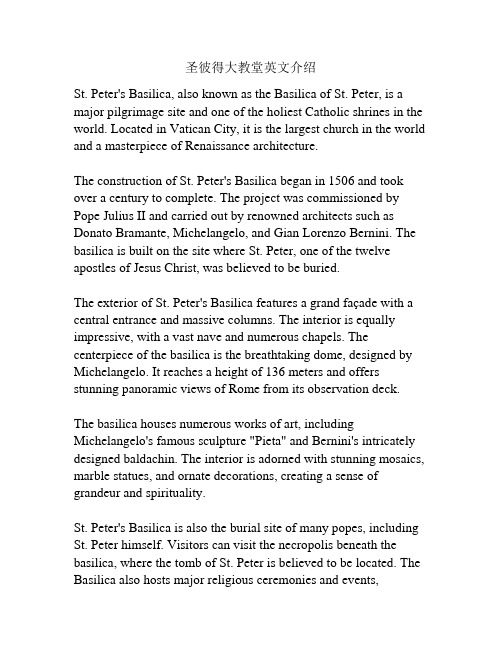
圣彼得大教堂英文介绍St. Peter's Basilica, also known as the Basilica of St. Peter, is a major pilgrimage site and one of the holiest Catholic shrines in the world. Located in Vatican City, it is the largest church in the world and a masterpiece of Renaissance architecture.The construction of St. Peter's Basilica began in 1506 and took over a century to complete. The project was commissioned by Pope Julius II and carried out by renowned architects such as Donato Bramante, Michelangelo, and Gian Lorenzo Bernini. The basilica is built on the site where St. Peter, one of the twelve apostles of Jesus Christ, was believed to be buried.The exterior of St. Peter's Basilica features a grand façade with a central entrance and massive columns. The interior is equally impressive, with a vast nave and numerous chapels. The centerpiece of the basilica is the breathtaking dome, designed by Michelangelo. It reaches a height of 136 meters and offers stunning panoramic views of Rome from its observation deck.The basilica houses numerous works of art, including Michelangelo's famous sculpture "Pieta" and Bernini's intricately designed baldachin. The interior is adorned with stunning mosaics, marble statues, and ornate decorations, creating a sense of grandeur and spirituality.St. Peter's Basilica is also the burial site of many popes, including St. Peter himself. Visitors can visit the necropolis beneath the basilica, where the tomb of St. Peter is believed to be located. The Basilica also hosts major religious ceremonies and events,including the election of a new pope and the papal Mass on Easter Sunday.Visitors to St. Peter's Basilica can marvel at its architectural beauty, admire its art and historical treasures, and experience a sense of awe and reverence. It is a testament to the grandeur of the Catholic Church and a must-visit destination for anyone interested in history, art, or religion.。
梵蒂冈城英文介绍

梵蒂冈城英文介绍:One of the most recognizable[1] structures in the world, one can t say theyre been to Washington D.C. until they have seen the White House. The home of the leader of the free world is open to the public five days a week from 10 noon.Originally known as the Executive Mansion[2], construction of the White House began in 1792 under the direction of George Washington. The structure was not pleted until 1800, so ironically[3] Washington is the only President not to live there.The executive mansion was torched by British troops in 1814, during the War of 1812. The structural damage caused by the fire was repaired but theexterior sandstone walls were still black with fire damage. The walls were then painted white, givingbirth to the nick name The White House. An act of Congress made this the official name in 1902.Every President has left his mark upon the White House. Thomas Jefferson added terraces to the east and west wings, Andrew Jackson installed running water,and Harry Truman added a porch. Bill Clintons addition to the White House was an indoor-running track(Used to relieve tension and cheeseburgers).In order to visit the White House, you must first pick up a free ticket from the White House Visitor Center located at 1450 Pennsylvania Ave. During the height of tourist season, tickets are nearlyimpossible to get. Get in line by 7AM (the facility opens at 7:30) and you might have a chance. Ignore the scalpers that are selling free tickets.Guided tours can be arranged by contacting your representative or senator. Be on the look-out for Wolf Blitzer or other famous White House correspondents. Due to recent developments in the news, the number of reporters that usually surround the White house have swelled dramatically.The White House tour probably ranks high on a visitors list of things to do while in Washington D.C.,but the process to get tickets will definitely test your determination. The White House is open Tues. Sat. from 10 AM Noon, but you need to get one of the free tickets for admittance. Herein lies the problem, because tickets for that days tours can only be picked up at the White House Visitors Center and they run out very quickly. Although the center opens at 7:30 AM,the line to get tickets starts to form sometime around five. Therefore most people have to be satisfied with seeing only the exterior of the White House. The Visitors Center has nice displays on the history ofthe White House to mollify the disappointed visitors who couldnt get tickets. Dont expect to get ticketsfor the tour if you arrive after 9 AM.If you are lucky enough to get tickets, they will be sted with the departure time of your tour. Bleachers have been set up on the Ellipse so visitors can sit until the tour staff collects them. The twenty minute tour consists of five rooms: The East Room, Green Room, Blue Room, Red Room and the State Dining Room.The Presidents GardenThe lovely White House gardens of today and those that preceded[4] them are the theme of the Presidents Garden organized by the White House Historical Association, the White House Curators Office, and the Superintendent of the Grounds fo rthe White House in cooperation with the National Park Service. Theexhibit traces the history of the White House grounds from the 1790s to the present day and displays more than 60 historic black and white and color photographs, paintings, documents and other illustrations from the past and present.White House Visitor Center, 1450 Pennsylvania Ave., NW. Open daily from 7:30am to 4pm. For moreinformation cal the National Park Service at (202)619-6350.。
梵蒂冈教堂英文作文
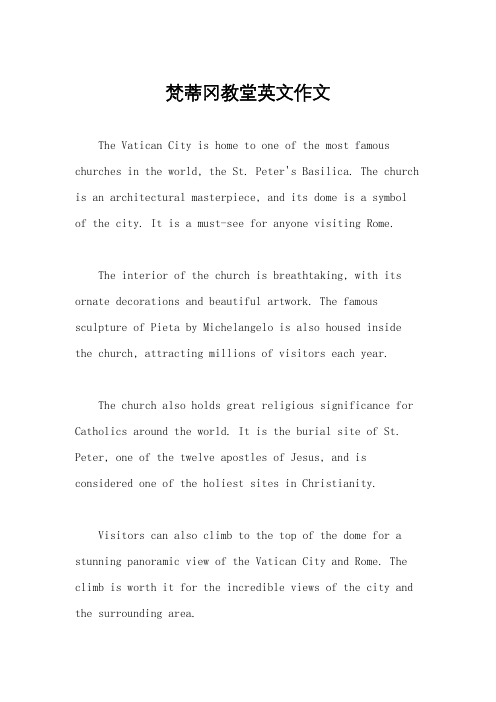
梵蒂冈教堂英文作文The Vatican City is home to one of the most famous churches in the world, the St. Peter's Basilica. The church is an architectural masterpiece, and its dome is a symbol of the city. It is a must-see for anyone visiting Rome.The interior of the church is breathtaking, with its ornate decorations and beautiful artwork. The famous sculpture of Pieta by Michelangelo is also housed inside the church, attracting millions of visitors each year.The church also holds great religious significance for Catholics around the world. It is the burial site of St. Peter, one of the twelve apostles of Jesus, and is considered one of the holiest sites in Christianity.Visitors can also climb to the top of the dome for a stunning panoramic view of the Vatican City and Rome. The climb is worth it for the incredible views of the city and the surrounding area.The Vatican City is a unique and fascinating place to visit, with its rich history, beautiful architecture, and religious significance. It is a must-see destination for anyone interested in art, history, or religion.。
意大利圣彼得大教堂简介

意大利圣彼得大教堂简介圣彼得大教堂(Basilica di San Pietro)是天主教罗马教廷的总教堂,位于意大利罗马梵蒂冈城内的圣彼得广场(Piazza San Pietro)上。
它是世界上最大的教堂建筑,也是天主教会的象征之一。
圣彼得大教堂是意大利文艺复兴时期的杰作,由多位著名建筑师参与设计和建造,包括米开朗基罗、拉斐尔和布拉曼特等。
圣彼得大教堂的建筑风格融合了古典和文艺复兴风格,以其宏伟壮丽的外观和精美细致的内部装饰而闻名于世。
教堂的立面由巨大的柱廊和雕塑组成,中央为大圆顶,两侧有钟楼和尖顶。
圆顶高达138米,是世界上最高的教堂圆顶,也是罗马的地标之一。
进入圣彼得大教堂的中央大门,首先映入眼帘的是宽敞而庄严的内部空间。
教堂的内部由巨大的中殿和多个侧殿组成,中殿两侧是壮丽的雕塑和绘画作品,展示了宗教历史和圣经故事。
教堂内还有许多宝贵的艺术品,如米开朗基罗的《圣彼得的抵抗》和《圣伯多禄的坐像》等。
此外,圣彼得大教堂内还有许多宗教仪式和活动,吸引了来自世界各地的信徒和游客。
圣彼得大教堂的地下宝库是一个真正的宝藏,收藏了许多宗教和历史文物。
游客可以参观圣彼得大教堂的地下宝库,欣赏到珍贵的圣骸和圣器。
而登上教堂的圆顶,可以俯瞰整个梵蒂冈城和罗马市区的壮丽景色。
圣彼得大教堂每年吸引了数百万游客,成为意大利最重要的旅游景点之一。
参观教堂需要购买门票,并遵守教堂的参观规定。
为了保护教堂的文化和历史遗产,游客在参观时需保持安静,不得拍照或使用闪光灯。
除了作为宗教场所和旅游景点,圣彼得大教堂还是天主教会的重要礼拜和庆典场所。
每年的复活节和圣诞节,教宗会在圣彼得大教堂举行盛大的弥撒和仪式,吸引了成千上万的信徒前来参加。
圣彼得大教堂是一座宏伟壮丽的教堂建筑,代表了意大利文艺复兴时期的杰作。
它不仅是天主教会的总教堂,也是意大利的重要象征之一。
游客可以在这里欣赏到丰富的艺术和文化遗产,感受到宗教的庄严和力量。
无论是信徒还是游客,圣彼得大教堂都是一个值得一游的地方。
梵蒂冈-圣彼得大教堂

梵蒂冈-圣彼得⼤教堂 1 St. Peters cathedral, the Vatican Today I want to share the Vatican photos with you.Natural geographical area 0.44 square kilometers, is the smallest country of the world. Located in the Italian capital Rome northwest-by the Vatican highlands. Territory including St Peter's square, St. Peter's cathedral, the Vatican and the Vatican museum, etc.Population 0.1 million(July 2000), including the resident population only 540 people, mainly Italian. The official language is Italian and Latin. Roman cathotic.⾃然地理: ⾯积为0.44平⽅公⾥,是世界上最⼩的国家。
位于意⼤利⾸都罗马城西北⾓的梵蒂冈⾼地上。
领⼟包括圣彼得⼴场、圣彼得⼤教堂、梵蒂冈宫和梵蒂冈博物馆等。
⼈⼝:0.1万(2000年7⽉),其中常驻⼈⼝仅540⼈,主要是意⼤利⼈。
官⽅语⾔为意⼤利语和拉丁语。
信奉天主教。
The Vatican, Saint Peter's cathedral, it's the biggest church of the world.The Saint Peter's square.The Saint Peter's square.The Saint Peter's cathedral, the biggest church of the world.The Saint Peter's cathedral, it's the biggest church of the world.。
圣彼得教堂
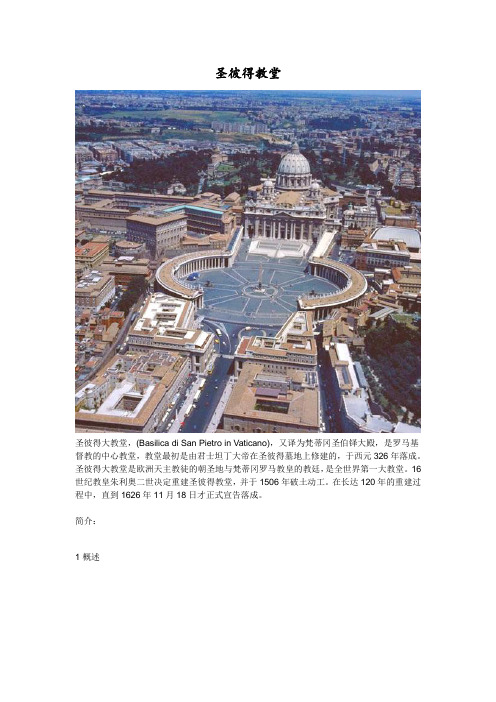
圣彼得教堂圣彼得大教堂,(Basilica di San Pietro in Vaticano),又译为梵蒂冈圣伯铎大殿,是罗马基督教的中心教堂,教堂最初是由君士坦丁大帝在圣彼得墓地上修建的,于西元326年落成。
圣彼得大教堂是欧洲天主教徒的朝圣地与梵蒂冈罗马教皇的教廷,是全世界第一大教堂。
16世纪教皇朱利奥二世决定重建圣彼得教堂,并于1506年破土动工。
在长达120年的重建过程中,直到1626年11月18日才正式宣告落成。
简介:1 概述圣彼得大教堂罗马基督教的中心教堂,欧洲天主教徒的朝圣地与梵蒂冈罗马教皇的教廷,位于梵蒂冈,是全世界第一大圆顶教堂。
登教堂正中的圆穹顶部可眺望罗马全城;在圆穹内的环形平台上,可俯视教堂内部,欣赏圆穹内壁的大型镶嵌画。
其中比较著名的有米开朗琪罗“哀悼基督”的雕像。
圣彼得大教堂俯视图拉斐尔的《雅典学院》油画等。
圣彼得大教堂是现在世界上最大的教堂,总面积2.3万平方米,主体建筑高138米,长约211米,最多可容纳近6万人同时祈祷,只不过必须衣冠整齐并通过安检才可以进入教堂。
2 地理位置梵蒂冈城(CittàdelVaticano)是梵蒂冈城国的首都、世界天主教的中心、罗马教廷所在地,位于意大利首都罗马西北角的梵蒂冈高地上,壹伯河右岸。
北、西、南3面有高墙与罗马市隔开,而东面的圣彼得广场同罗马市畅行无阻。
梵蒂冈是世界上的一个特殊城国,梵蒂冈城区便是梵蒂冈国家的疆域。
3 自然气候圣彼得大教堂梵蒂冈属亚热带地中海气候,平均气温1月7℃,7月24℃。
这里一年四季都充满了活力,任何时候来此观光,都会让人非常愉快。
春季(4月份到5月份)和秋季(10月到11月份),气候宜人,游人相对比较少,是来此悠闲度假的好时间,而7至9月为梵蒂冈的旅游旺季。
4 旅游景区进入圣彼得大教堂,你一定会被各种艺术珍品迷住了眼,但两位艺术大师的杰作是一定要仔细欣赏的。
一位是被称为“巴洛克艺术之父”的天才雕塑家贝尔尼尼。
ST PAUL'S CATHEDRAL圣彼得大教堂
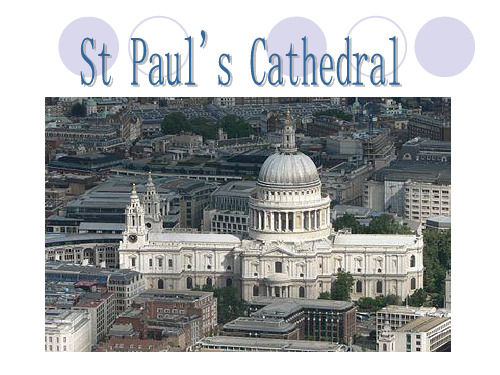
Cathedral Services
Services held at St Paul's have included the funerals of Lord Nelson, the Duke of Wellington and Sir Winston Churchill; Jubilee celebrations for Queen Victoria; peace services marking the end of the First and Second World Wars; the wedding of Charles, Prince of Wales and Lady Diana Spencer, the launch of the Festival of Britain and the thanksgiving services for the Golden Jubilee, the 80th Birthday and the Diamond Jubilee of Elizabeth II.
The interior of the dome
Eight equal arches
Depictions of St Paul's
St Paul's Cathedral has been depicted many times in paintings, prints and drawings. Among the well-known artists to have painted it are Canaletto, Turner, Daubigny, Pissarro, Signac, Derain, Lloyd Rees.
Location
City of London
梵蒂冈教堂英文作文
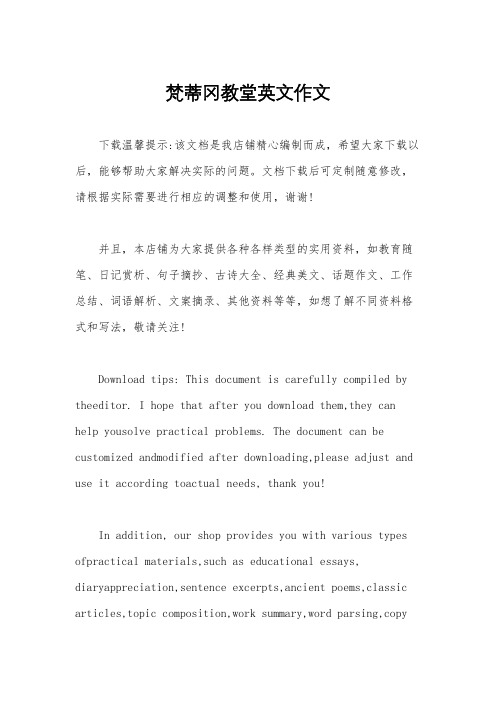
梵蒂冈教堂英文作文下载温馨提示:该文档是我店铺精心编制而成,希望大家下载以后,能够帮助大家解决实际的问题。
文档下载后可定制随意修改,请根据实际需要进行相应的调整和使用,谢谢!并且,本店铺为大家提供各种各样类型的实用资料,如教育随笔、日记赏析、句子摘抄、古诗大全、经典美文、话题作文、工作总结、词语解析、文案摘录、其他资料等等,如想了解不同资料格式和写法,敬请关注!Download tips: This document is carefully compiled by theeditor. I hope that after you download them,they can help yousolve practical problems. The document can be customized andmodified after downloading,please adjust and use it according toactual needs, thank you!In addition, our shop provides you with various types ofpractical materials,such as educational essays, diaryappreciation,sentence excerpts,ancient poems,classic articles,topic composition,work summary,word parsing,copyexcerpts,other materials and so on,want to know different data formats andwriting methods,please pay attention!The Vatican church is really amazing. It's so grand and beautiful. You can feel the solemnity and holiness as soon as you enter.There are so many wonderful artworks and decorations inside. The paintings and sculptures are just breathtaking.The architecture of the Vatican church is unique. It shows the great wisdom and creativity of the architects.People come from all over the world to visit this special place. It's like a magnet that attracts everyone.。
世界上最大的教堂
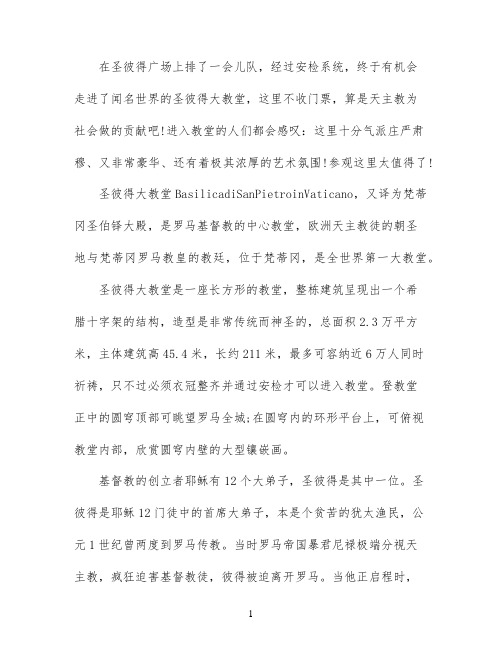
在圣彼得广场上排了一会儿队,经过安检系统,终于有机会走进了闻名世界的圣彼得大教堂,这里不收门票,算是天主教为社会做的贡献吧!进入教堂的人们都会感叹:这里十分气派庄严肃穆、又非常豪华、还有着极其浓厚的艺术氛围!参观这里太值得了!圣彼得大教堂BasilicadiSanPietroinVaticano,又译为梵蒂冈圣伯铎大殿,是罗马基督教的中心教堂,欧洲天主教徒的朝圣地与梵蒂冈罗马教皇的教廷,位于梵蒂冈,是全世界第一大教堂。
圣彼得大教堂是一座长方形的教堂,整栋建筑呈现出一个希腊十字架的结构,造型是非常传统而神圣的,总面积2.3万平方米,主体建筑高45.4米,长约211米,最多可容纳近6万人同时祈祷,只不过必须衣冠整齐并通过安检才可以进入教堂。
登教堂正中的圆穹顶部可眺望罗马全城;在圆穹内的环形平台上,可俯视教堂内部,欣赏圆穹内壁的大型镶嵌画。
基督教的创立者耶稣有12个大弟子,圣彼得是其中一位。
圣彼得是耶稣12门徒中的首席大弟子,本是个贫苦的犹太渔民,公元1世纪曾两度到罗马传教。
当时罗马帝国暴君尼禄极端分视天主教,疯狂迫害基督教徒,彼得被迫离开罗马。
当他正启程时,遇上耶稣“显灵”阻止他离开。
彼得顿时醒悟,于是继续留在罗马布道。
公元64年10月13日,他被尼禄钉死在十字架上。
后来的基督徒在他殉道处建立了墓地和讲台,4世纪时君士坦丁皇帝在圣彼得墓地上修建了一所教堂,1506年教皇朱利奥二世决定改建为大教堂并命名为圣彼得教堂,历经120年,直到1626年11月18日才正式宣告落成。
教堂最初是由君士坦丁大帝于西元326-333年在圣彼得墓地上修建的,称老圣彼得大教堂,于公元326年落成,为巴西利卡式建筑。
16世纪,教皇朱利奥二世决定重建圣彼得大教堂,并于1506年破土动工。
在长达120年的重建过程中,意大利最优秀的建筑师布拉曼特、米开朗琪罗、德拉·波尔塔和卡洛·马泰尔相继主持过设计和施工,直到1626年11月18日才正式宣告落成,称新圣彼得大教堂。
- 1、下载文档前请自行甄别文档内容的完整性,平台不提供额外的编辑、内容补充、找答案等附加服务。
- 2、"仅部分预览"的文档,不可在线预览部分如存在完整性等问题,可反馈申请退款(可完整预览的文档不适用该条件!)。
- 3、如文档侵犯您的权益,请联系客服反馈,我们会尽快为您处理(人工客服工作时间:9:00-18:30)。
St. Peter's Basilica (Italian San Pietro in Vaticano) is a major basilica in Vatican City, an enclave of Rome. St. Peter's was until recently the largest church ever built (it covers an area of 23,000 m² and has a capacity of over 60,000), and it remains one of the holiest sites in Christendom. Ancient tradition has it that St. Peter's Basilica was built at the place where Peter, the apostle who is considered the first pope, was crucified and buried; his tomb is under the main altar. Other popes are also buried in and below the basilica. Contrary to what one might reasonably assume, St. Peter's is not a cathedral - the pope's cathedral is St. John Lateran. The current location of St. Peter's Basilica is the site of the Circus of Nero in the first century AD. After Emperor Constantine officially recognized Christianity he started construction (in 324) of a great basilica in this exact spot, which had previously been a cemetery for pagans as well as Christians. In the mid-15th century it was decided that the old basilica should be rebuilt. Pope Nicholas V asked architect Bernardo Rossellino to start adding to the old church. This was abandoned after a short while, but in the late 15th century Pope Sixtus IV had the Sistine Chapel started nearby. Construction on the current building began under Pope Julius II in 1506 and was completed in 1615 under Pope Paul V. Donato Bramante was to be the first chief architect. Many famous artists worked on the "Fabbrica di San Pietro" (as the complex of building operations were officially called). Michelangelo, who served as main architect for a while, designed the dome, and Bernini designed the great St. Peter's Square. The following description is a virtual tour that follows this basic path: views from afar; St. Peter's Square; exterior of St. Peter's Basilica; nave; right aisle and transept; dome area with baldacchino; cathedra of St. Peter; left transept and aisle; and crypt/grottoes. See our St. Peter's Basilica Photo Gallery for a visual tour. St. Peter's Square Providing a fitting approach to the great church is the huge, elliptical St. Peter's Square (Piazza San Pietro), designed by Bernini and built between 1656 and 1667. There are two beautiful fountains in the square, the south/left one by Carlo Maderno (1613) and the northern/right one by Bernini (1675). In the center of the square is a 25.5-meter-tall obelisk, which dates from 13th-century BC Egypt and was brought to Rome in the 1st century to stand in Nero's Circus some 275 yards away. It was moved to its present location in 1585 by order of Pope Sixtus V. The task took four months and is said to have been done in complete silence on pain of death. If you include the cross on top and the base, the obelisk reaches 40m. The square is outlined by a monumental colonnade by Bernini, its open arms symbolically welcoming the world into the Catholic Church. Between the obelisk and each fountain is a circular stone that marks the focal points of an ellipse. If you stand on one of these points, the two rows columns of the colonnade line up perfectly and appear to be just a single row. On top of the colonnade are 140 statues of saints, crafted by a number of sculptors between 1662 and 1703. To the right of the southern gate of the colonnade is St. Macrina, grandmother of the Cappadocian fathers, followed by some founders of religious orders: St. Dominic, St. Francis, St. Bernard, St. Benedict, and St. Ignatius of Loyola. Some of the apostles are at the far end of the colonnade, outside the square and down the street: look for Paul and John on the south side (on the left as you walk to the square). More details here. Near the stairs to the basilica at the front of the square are colossal statues of Sts. Peter and Paul, the patron saints of Rome. These were ordered by Pope Pius IX on Easter 1847, who wanted to replace the existing smaller ones. The new statues had been commissioned bythe previous pope for St. Paul Outside the Walls. Peter was sculpted by Giuseppe De Fabris in 1838-40 and stands 5.55m in height, on a pedestal 4.91m high. Paul was sculpted in 1838 by AdamoTadolini, and is also 5.55m in height, on a pedestal 4.91m high. Exterior of St. Peter's Basilica The dome of St. Peter's was designed by Michelangelo, who became chief architect in 1546. At the time of his death (1564), the dome was finished as far as the drum, the base on which domes sit. The dome was vaulted between 1585 and 1590 by the architect Giacomo della Porta with the assistance of Domenico Fontana, who was probably the best engineer of the day. Fontana built the lantern the following year, and the ball was placed in 1593. The great double dome is made of brick and is 42.3 metres in interior diameter (almost as large as the Pantheon), rising to 120 metres above the floor. In the early 18th century cracks appeared in the dome, so four iron chains were installed between the two shells to bind it. The four piers of the crossing that support the dome are each 60 feet (18 meters) across. Uniquely, Michelangelo's dome is not a hemisphere, but a parabola: it has a vertical thrust, which is made more emphatic by the bold ribbing that springs from the paired Corinthian columns, which appear to be part of the drum, but which stand away from it like buttresses, to absorb the outward thrust of the dome's weight. Above, the vaulted dome rises to Fontana's two-stage lantern, capped with a spire. The grand façade is 116 m wide and 53 m high. Built from 1608 to 1614, it was designed by Carlo Modeno. The central balcony is called the Loggia of the Blessings, and is used for the announcement of the new pope with "HabemusPapum" and his UrbietOrbi blessing. The relief under the balcony, by Buonvicino, represents Christ giving the keys to St. Peter. The facade is topped by 13 statues in travertine. From left, the statues represent: Thaddeus, Matthew, Philip, Thomas, James the Elder, John the Baptist, Christ the Redeemer (in the center), Andrew, John the Evangelist, James the Younger, Bartholomew, Simon and Matthias. St. Peter's statue in this set is inside. Two clocks are on either side; the one on the left is electrically operated since 1931, with its oldest bell dating to 1288. Stretching across the facade is the dedicatory inscription: IN HONOREM PRINCIPIS APOST PAVLVS V BVRGHESIVS ROMANVS PONT MAX AN MDCXII PONT VII (In honor of the prince of apostles; Paul V Borghese, pope, in the year 1612 and the seventh year of his pontificate) Between the façade and the interior is the portico. Mainly designed by Maderno, it contains an 18th century statue of Charlemagne by Cornacchini to the south, and an equestrian sculpture of Emperor Constantine by Bernini (1670) to the north.。
